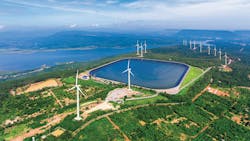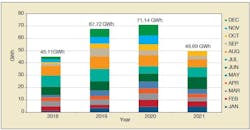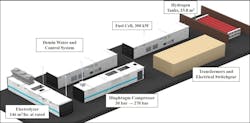Thailand Harnesses Wind Energy Potential
Renewable energy sources have been gaining momentum in power generation over the last decade due to decreasing costs and breakthroughs in renewable energy technologies. Furthermore, many countries are now committed to achieving a clean, secure and reliable power supply. In 2015, the United Nations established 17 sustainable development goals, including affordable and clean energy, sustainable cities and communities, and climate action. During the 26th session of the Conference of Parties (COP 26), commitments were made at the United Nations Framework Convention on Climate Change in Glasgow 2021.
The facilitation of renewable energy resources integration is required to mitigate climate change in the energy sector. Global electricity consumption is expected to grow exponentially, which will lead to an increase in electrical energy generation. Renewable energy resources will play a significant role in fulfilling this demand and providing a sustainable energy transition.
Thailand is one such country that has seen considerable growth in electricity consumption because of continued economic growth, including population growth. As a result, the country updated its Power Development Plan 2015 (PDP2015) as PDP2018 Revision 1 to focus on electricity generation that could keep up with the increasing electricity consumption and would make the most of renewable power generation technology improvements.
Wind Energy Growth
Electricity generation from wind energy in Thailand began as a pilot project at Laem Phromthep on Phuket Island in 1983 by the Electricity Generating Authority of Thailand (EGAT). EGAT chose this location because the annual average wind speed throughout the year at hub height is around 5 m/sec (16.4 ft/sec). With a total capacity of 170 kW, the wind farm is still operational after almost 40 years in service and continues to generate electricity.
Following the success of this pilot project, EGAT has continued to explore potential locations to install new onshore wind turbines. The deployment of wind power generation in Thailand has grown at a moderate rate even though the country experiences relatively low wind speeds.
In 2008, the utility established two groups of 1.25-MW wind turbines with a total capacity of 2.5 MW, which was the largest wind farm in Thailand at the time. The wind farm also has an annual average wind speed of about 5 m/sec to 6 m/sec (16.4 ft/sec to 19.7 ft/sec). It is located at the upper reservoir of the Lam Takong Jolabha Vadhana power plant in Khlongphai, a subdistrict of the Sikhio District, Nakhon Ratchasima.
From 2017 onward, wind turbine installations have increased exponentially, with a growth rate of about 70% per year. In 2019, Thailand installed new wind turbines with a cumulative capacity of 404 MW, increasing the total capacity of wind power generation to 1507 MW. The total capacity of 1507 MW is halfway toward the 3-GW goal EGAT set in its PDP2018 and Alternative Energy Development Plan (AEDP). More than one-half of new wind turbine installations have been in the northeastern region of Thailand, followed by the southern region, northern region and central region, respectively.
Subsidies For More Growth
As a wind energy subsidy, a feed-in tariff (FiT) was launched in 2015 with a 6.06/kWh (US$0.176/kWh) energy tariff for 20 years. The subsidy was considered successful because the project attracted several developers, generating more than 1500 MW.
Regional Wind Potential
Thailand is located near the equator and has relatively low to moderate wind speeds. Its northeastern, western and southern regions have the most significant wind energy potential. An annual average wind speed is about 6 m/sec at 50 m (164 ft). However, those areas are very remote from load centers and transmission lines.
The technical potential of wind energy could reach 13 GW across Thailand. The offshore wind energy potential has been studied, and the Gulf of Thailand offers the most promising area, with an estimated magnitude of 7 GW. More than one-half of the potential is in the Bay of Bangkok, the northern part of the Gulf of Thailand. Assuming a capacity factor of 25% at a hub height of 120 m (394 ft), the total energy generation would reach 15 TWh per year.
Wind Challenges
Thailand faces many challenges in the development and promotion of wind energy. Three of the challenges are as follows:
1. Land and community issues remain problematic for wind farm projects. The average wind speed of Thailand is low to medium range. The potential wind energy areas are around the Thai Gulf and higher-elevation regions, with an average wind speed between 5 m/sec to 6 m/sec at around 50 m. Wind farms require significant space to operate, and most of the potential area with the highest average wind speed is often in mountainous terrain or reserved forests. Therefore, installing a wind turbine requires permission from the related government agency to use the area.
2. Wind farm projects require high capital investment costs to pay for the wind turbine grid connection, civil work and construction, in addition to the fixed and variable operating and maintenance costs. Therefore, a reasonable energy tariff would be necessary for wind farm projects to break even within their lifetime.
3. Environmental impacts are inevitable around the area of the wind turbine. For example, a wind turbine could negatively impact the scenery, cause noise pollution and harm animals, for example. A preliminary environmental impact analysis (EIA) is required to help manage stakeholder relations.
Power Plant Case Study
Following the successful wind turbine project of two sets of 1.25-MW wind turbines installed in 2008 at the Lam Takong Jolabha Vadhana power plant, the annual average wind speed was 5 m/sec to 6 m/sec over the upper reservoir of Lam Takong Jolabha Vadhana.
This was considered a good site for expansion of the wind farm. In June 2017, EGAT developed a second phase of the project, installing an additional 12 wind turbines with a total capacity of 24 MW, or 2 MW each, for a total power capacity of 26.5 MW. Each turbine is 94 m (295 ft) high with a rotor diameter of 116 m (381 ft). The project cost 1.4 billion (US$40.8 million), and the Phase 2 Takong wind turbine project was commissioned in April 2018. Energy production from this wind turbine farm supplies many households in the area. The recorded wind energy produced from 2018 to 2021 was 45.11 GWh (2018), 67.72 GWh (2019), 71.14 GWh (2020) and 49.69 GWh (as of October 2021) , with capacity factors of 21.92% (2018), 32.83% (2019) and 31.43% (2020), respectively.
Untapped Potential
A large wind-energy potential in Thailand remains untapped. Wind energy will help the country to meet its total energy consumption. In 2019, new installations of wind turbines were 404 MW, bringing the cumulative capacity of wind power generation to 1507 MW. The growth rate of wind energy between 2017 and 2019 has been around 75% each year, and it is expected to increase. By the end of 2036, new wind energy integration will be about 1485 MW, which will lead to a national cumulative capacity of wind power generation up to 3 GW, or accounting for 30% of the country’s total power generation from alternative energy, according to PDP2018.
Most of the wind turbines at the 24-MW wind farm installed at the Lam Takong Jolabha Vadhana power plant operate optimally with slight seasonal wind variations of both speed and direction. The capacity factor of this wind farm represents a high value of 31.97%, which shows the efficiency of the power plant.
Conversely, the availability is unstable and needs improvement, varying from 57.29% in January 2019 to 97.22% in August 2020. The reasons for this huge variation are attributable to a forced outage with issues on spare part replacement requirements (almost all spare parts purchased from original equipment manufacturers), a forced outage because of a line-to-ground fault and a planned outage for yearly inspections (semiannual and annual inspections).
Future work will monitor other wind farms’ performance in Thailand. The EGAT wind hydrogen hybrid system with fuel cell technology has increased the availability and reliability of electricity. Hydrogen is generated during off-peak hours at night and used during peak hours in the daytime. The renewable energy generated from wind turbines at the Lam Takong Jolabha Vadhana power plant can supply about 0.8% of Nakhon Ratchasima province’s electricity demand. This is helping Thailand to comply with the commitments made during the COP 26.
Thailand’s Greenhouse Gas Management Organization set the coefficient of greenhouse gas (GHG) emission factors from electricity generation as 0.5692 total carbon dioxide/MWh. From January 2018 to October 2021, the carbon dioxide was reduced by 132,996.08 total carbon dioxide. During the 46 months of operation, the wind turbine produced electricity sufficient to cover 48% of the installation cost as a fixed cost. Therefore, EGAT will reach the break-even point after the next five years, which does not include operation and maintenance costs.
Dr. Prapapong Vangtook ([email protected]) graduated with a doctor of engineering degree in energy technology from the Asian Institute of Technology. He is a senior mechanic engineer in the research and innovation division at EGAT.
Panu Suwicharcherdchoo ([email protected]) graduated with a MSME degree from King Mongkut’s Institute of Technology North Bangkok. He works at EGAT’s Lamtakong Jolabha Vadhana hydropower plant.
Jarudate Vorasee ([email protected]) graduated with a master’s degree in renewable energy and clean technology from the University of Manchester. He is an electrical engineer in the grid modernization technology department at EGAT.
About the Author
Prapapong Vangtook
Prapapong Vangtook ([email protected]) graduated with a doctor of engineering degree in energy technology from the Asian Institute of Technology. He is a senior mechanic engineer in the research and innovation division at EGAT.
Panu Suwicharcherdchoo
Panu Suwicharcherdchoo ([email protected]) graduated with a MSME degree from King Mongkut’s Institute of Technology North Bangkok. He works at EGAT’s Lamtakong Jolabha Vadhana hydropower plant.
Jarudate Vorasee
Jarudate Vorasee (mail address required) graduated with a master’s degree in renewable energy and clean technology from the University of Manchester. He is an electrical engineer in the grid modernization technology department at EGAT.



